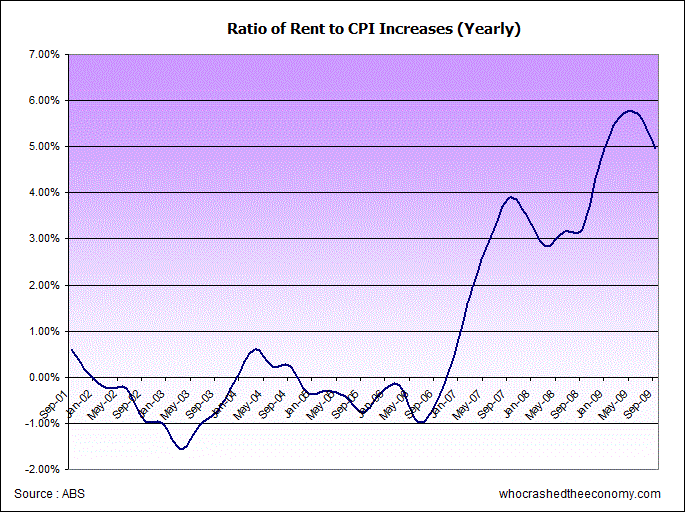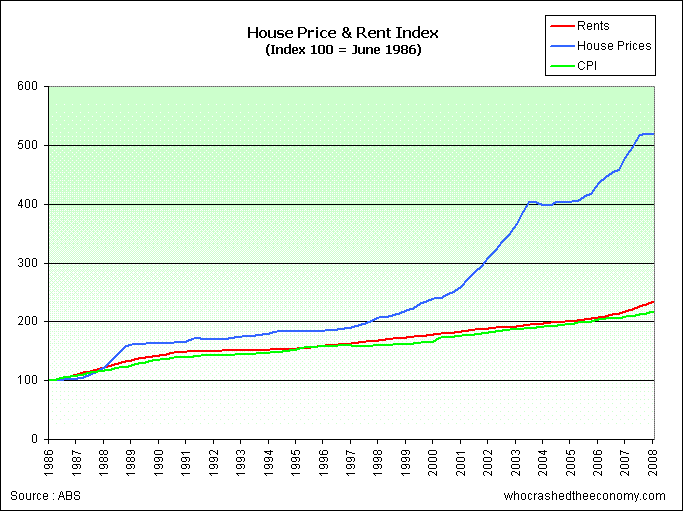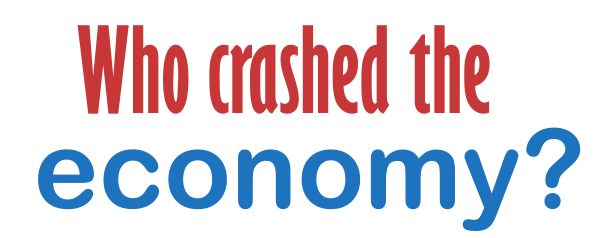Some of the papers this week are running stories about sky rocking rents. Portrayed as a good thing, the reports show rents for houses in Rose Bay, NSW up 58.3%, and prices for units in West End in Brisbane up 39.4% among just some of the double digit rises.
Even in little old Adelaide, the News Limited reports Happy renters lift market prices saying rents for homes in Magill are up 16.7% and Glenelg Units are up 20.0%. I’m sure the renters are indeed happy!
Cutting through all the real estate hype, Nationally rents on houses only increased 3.4%. But all the hype is enough to make any landlord jump, and put up rents 40% this year, in fear that they will miss out.

The graph above shows the ratio between rent increases and CPI. Historically, rents have always increased at a sustainable pace in line with CPI. Then in late 2006 you will probably remember the endless rents through the roof articles. Landlords around the country, lead on by lobby groups started jacking up rents, at a pace far greater than CPI.

Prior to the start of Australia’s housing bubble, house prices only increased in the long term at the rate of inflation. When the adrenalin of current bubble kicked it, home prices were out striping incomes by a long way. Despite the fact that today many people believe money grows on trees, the real fact is the money has to come from somewhere. First Australian’s dipped into savings, then when that ran out, people turned to credit. As more and more of the household’s budget is eaten up with housing expenses, discretionary spending is being cut back and this is bad news for jobs.
In Australia using 2006 figures, 35% of households have a mortgage, 28.5% rent. Now with rents out pacing household income, the same sacrifices have to be made. Unfortunately this comes at a bad time, with many employees on reduced hours, and some even losing their jobs. The more rents out pace income, the less money will be spend on goods and services and more jobs will be in the firing line.
While housing expenses (both homes and rents) out pace household incomes, not a lot can be done to save jobs.
Reality is, eventually this will correct. More and more people are being forced out off rental properties as they can’t meet the repayments. The money is simply not there. Moving back in with the parents is one option, boarding with several people and splitting the expenses is just another. SQM research shows vacancy rates are starting to trend up in many areas.
An article in the Brisbane Times also reports people turning to public housing :
MORE Australians may be forced to turn to public housing because prices and rents have ballooned well above the inflation rate in the past decade, a federal report on welfare says.
The Australian Institute of Health and Welfare says house prices have increased at twice the rate of inflation since 1996 and rentals are almost $100 a week higher than if they had gone up in step with inflation since 1996.
That’s another $100 a week not supporting jobs.
» Housing, rental balloon leaves more in need – The Brisbane Times, 17th November 2009.
» Happy Renters Lift Market Prices – Adelaide Now, 18th November 2009.
» Griffith rents increase by 41pc – The Canberra Times, 29th November 2009.
» Rents rise across the country – The Age, 18th November 2009.
» Rents soar 40 per cent in inner-city Brisbane – The Brisbane Times, 18th November 2009.

Nice summary. Be interesting to see where this is headed. I am sceptical of the Rose Bay data considering how many ‘houses’ are actually available for rent, – mostly units would be available for rent in this area.
Not sure if increased rental costs will pressure wage inflation given the semi-slack labour market, or if in the long run the cities may lose a little of their attractiveness to those on the margin.